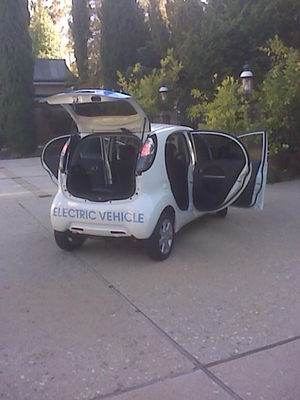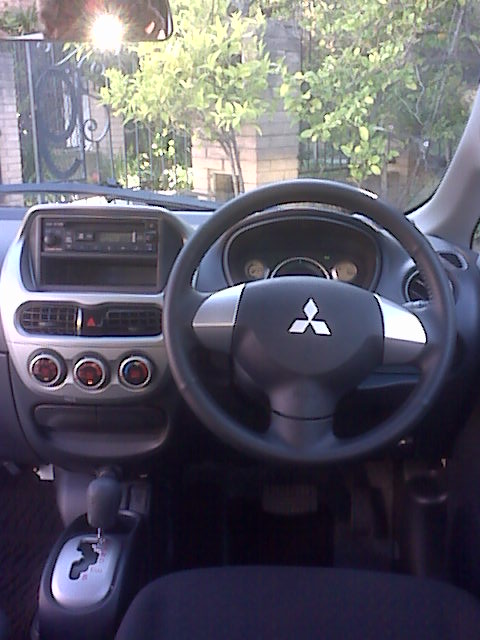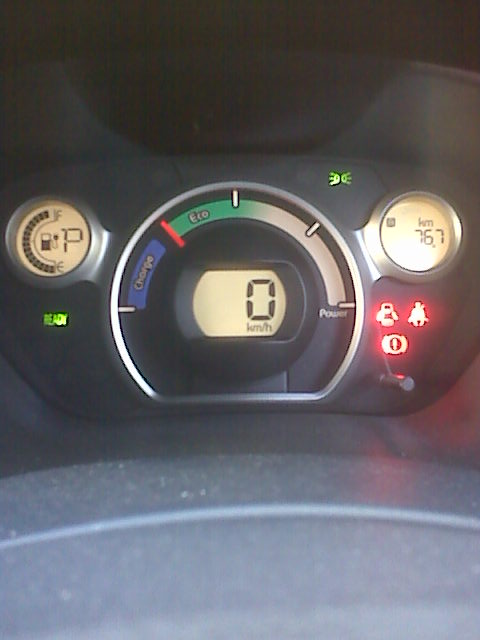"It's not easy bein' green..."
Thus sangeth (singeth?) Kermit the Frog several decades back, and as it turns out, he was not kidding. Especially when it comes to cars.
Car companies worldwide should have paid heed to those simple words many years ago.
Both Nissan and General Motors will be selling, in the US, green cars towards the end of this year.
But Mitsubishi is also bringing out their own version of a green car. i-MiEV (Mitsubishi innovative electric vehicle, pronounced "eye-meev") has been for sale for about two years in Japan, and some 20,000 units have left showroom floors at a cost of around $23,000 US dollars.
People who stopped me as I was getting into or out of the car during the week I had it had a natural inquisitiveness, but very few noticed the car was a Japan-only model, with the steering and gauges and controls (and driver!) on the right hand side.
My i-MiEV could be charged by 110 or 220 household current or by using a quick charging station, not yet available in the US market (though it sounds similar to the quick charging station that Leaf buyers will usually have installed in their garages).
i-MiEV weighs-in at 2,376 pounds, and charging times vary from 12 hours for 110 volts to 6 hours using the 220 volt plug-in option and using the quick charge system that will charge i-MiEV to 80% capacity in just 25 minutes.
The Lithium ion (Lion) battery pack powers a 64 horsepower/113 pound feet of torque Permanent Magnet Synchronous Motor and it's all expected to have a range of 80 to 100 miles as fast as 80 mph. Not much at all, really, especially for a family's primary car.
Both Japanese EVs are "pure electric" with relatively low and slow outputs. Both i-MiEV and Leaf will be marketed as a second or third (or fourth, etc) car and it's price (around $25,000 US) won't sting the wallet too much.
Only Volt is aimed at being a family's primary car with it's (claimed) 600-mile range and more spacious interior than the Japanese competition.
Leaf claims a 100-mile range and i-MiEV... Well, poor little i-MiEV needs a lot of changes before it will sell here.
Like Nissan's Leaf, i-MiEV is a "pure EV," which uses no gasoline or fuel other than electricity to go a wandering. Incidentally, in spite of Mitsu's suggested pronunciation, there seems to be a dozen -- or more -- ways to pronounce i-MiEV, so just take your best shot at it.
GM's Volt sets apart from other "pure green" vehicles because it has a small gasoline engine on board. That engine keeps the lithium ion battery pack charged. All a driver need worry about is the amount of fuel -- gasoline -- remains in the gas tank. 
This goes a long way to relieving "range anxiety," the fear of not knowing how many miles are left in the car's electric motor. It's the electricity remaining in the battery pack which tells an owner how many miles they have left. GM says there's no real connection between the gasoline engine and the drivetrain itself.
Starting in 1996, people were able to lease (no buying option on the car; leasing an EV1 kept the car under GM's control), through Saturn dealers, GM's EV1, an all-electric car. They were eventually taken back by GM and almost all were crushed or shredded; a few made it into museums and car collections kept by top GM executives.
i-MiEV will not be on-sale in the US until at least winter of 2011, but enthusiasts might think it's worth waiting for. That's because i-MiEV has rear-wheel drive and handles, quite literally, like a go-kart. Of course silence is the golden rule here, except for that ubiquitous and irritating beeping when "Reverse" is the automatic gear chosen.
As is the case with most gas/electric hybrids and especially pure EVs, i-MiEV can be just about any other car "off the line at the stop light Grand Prix," run thousands of times throughout the US every day. That's because electric motors display their torque almost instantly, and torque is also what we call "launch." So figure for the first 25 yards, you'll beat almost anything in i-MiEV. After that, we take no responsibility.
Because Nissan and GM have literally beaten Mitsubishi to the punch with their Leaf and Volt, Mitsubishi thought it a good idea to put as many press evaluation vehicles on the road as possible. The cars we auto journos drove were garishly painted, so much so that I asked a Mitsubishi PR person how much they were paying me for advertising their car in trendy West Los Angeles. I didn't get an answer to that one...
This Mitsubishi is a true four-door, four-passenger auto with room in the back for two real human beings. Bucket seats up front make for comfortable seating for driver and left seat passenger. The large battery pack is in the trunk, where'd you expect to find the spare tire. The radio in the center console is a last-minute toss-in, Mitsubishi folks telling me that by the time the car goes on-sale here, it will have a large video screen with all the expected bells and whistles.
With what appears to be the lowest going-in price of the two EVs and one extended range hybrid the first three cars making their electric intentions known, i-MiEV seems to have the corner on price. 
At this point, engineers need to figure out how to give the car more mileage range; 40 mpc (miles per charge) is already unacceptable when Nissan's EV claims 100 mpc and GM saying their Volt will hit 600 miles per thankful of gas thanks to its on-board gasoline-fired battery charger. The most miles I achieved on a fully-charged i-MiEV was about 70 miles in a combo of in-town and highway driving. There is an "electric gauge" that goes down like a $10 crack whore when you step on the gas the second you hit the freeway, and it'd be nice if all three of these cars could make some improvement in that department.
Photos by Steve Parker
Tune and call-in LIVE to Steve Parker every Saturday and Sunday on www.TalkRadioOne.com; details on that website.
Follow him on Twitter at: www.Twitter.com/autojourno